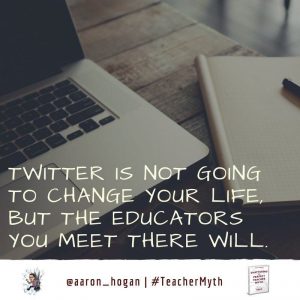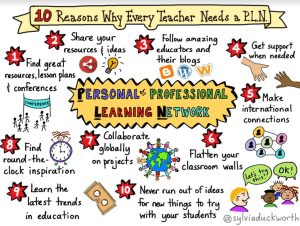Years and years ago, I started a Twitter account. I had no idea how to use it or what to use it for. All I knew is that it was something new and apparently everyone using Twitter loved it. At the time, I was a principal at a middle school, and I remember seeing other educators like Eric Sheninger (who was also a principal) using it and thinking to myself, how on earth do they even have time to be on Twitter that much and do they ever work?
I followed famous people thinking that would be interesting. It wasn’t. I didn’t know what to “tweet” about, so I didn’t. I honestly just didn’t understand Twitter and why it was so great. Frankly, I didn’t really want to understand it. I believe there were better ways to spend my time, so, I chose to not to use any longer.
Fast forward a few years later to my time at the district office level. I was in classrooms all the time and really liked the idea of tweeting out all the great things I experienced. I created a district account to share these classroom positives and realized people enjoyed seeing these tweets.
I took Twitter a step further and started figuring out educators I wanted to follow and learn from. I started by looking at Twitter profiles of my educator friends to see who they were following so I could give them a follow too. I also began following publications in education such as Edutopia as well as the KS state department of education and other government agencies and politicians. Seeing what these groups & people tweeted about gave me even more ideas of how Twitter could be a powerful tool in education.
Eventually, I came to understand what all the twitter lingo was and how meaningful the use of a hashtag was for following chats or groups. I admit I am not a big fan of chats as they are super fast within a 30-minute time frame, but I am a fan of reading the chats by searching the hashtag and learning from other educators.
What I realized I had done at the beginning of my Twitter experience was thinking it was like Facebook. I was already using Facebook and liking it, so I thought Twitter would be the same. For me, they have completely different uses. I use Facebook as a social tool and Twitter as a professional tool. This helped me to see the benefits of Twitter as an educator. There are some people that use both and are able to blend their personal & professional life. It is really a personal preference but, for the most part, I prefer to keep them separate.
Here’s the difference for me. Facebook is where you find people you already know (family & friends) whereas Twitter is where you find people you should know (experts in the field). I use Twitter to find people that will help me grow professionally. I follow topics that are interesting to me in the field of education. For example, I follow #ahstrojanfam, #joyfulleaders, #cultureed, #momsasprincipals and many others. Facebook is timeless and connects you to past memories. Twitter is all about the here and now. What can I learn that is current?
I am often misunderstood when it comes to my use of Twitter. My focus at AHS is around two areas; Great Instruction and Culture. I believe that Twitter supports these two efforts perfectly. What I hope teachers will understand is that it isn’t about having a Twitter account but how the tool is used professionally. Twitter is merely the vehicle to so much learning & growth.
The way I see it, we are no longer bound by time or geography to learn what is most useful for us in our professional learning. Twitter has had a tremendous impact on my learning, and I’m definitely not on Twitter all day long. Quite the opposite. Because Twitter is so easy to use once you learn how, I can get what I need in the time frame I’m willing to spend which can be anywhere from 3 to 30 minutes.
So, here are several ways and why I use Twitter every day.
- CONSUME information – It is the best way to stay current on instructional practices. I am kept abreast of the latest professional reading in education. I am able to gain information about workshops, edcamps, conferences, etc. I’ve been given an unlimited amount of ideas for ways to appreciate the staff. I read current blogs and articles which I then share with teachers if relevant. I gain new insights into instructional strategies & ideas from teachers in every content area.
- COLLABORATE with other principals around the country – Because of Twitter, I was able to grow an incredible professional learning network (PLN). I am a part of #momsasprincipals, #wisewomen, #joyfulleaders, and #principalsinaction. The #momsasprincipals and #wisewomen are two groups that I connect with every day on Voxer, which is a walkie-talkie app where we can talk and listen to one another on our own time.
- COMMUNICATE to our school community & beyond – I love to share what I see in AHS classrooms! There is exceptional teaching and learning every single day. I believe that if we don’t tell our story, someone else will. I share pictures of what I do whether it be a blog I wrote or something I did for staff. No, this is not to brag. I share ideas because I receive ideas from my PLN. We all give & take what we do so everyone learns from each other.
- CONNECT with students and experts – I often take selfies with the students. No, I don’t love taking selfies, but it is a way to connect with them, and they often ask. I will never turn them down. I love joining experts in my field whether it be teachers, principals or leaders. I learn a tremendous amount from them.
- MODEL how to use social media correctly – Our students are watching us. How are we modeling digital citizenship? We know that colleges and business are looking at social media before hiring. If we, as leaders in education, don’t model appropriate use of Twitter, who will?
I hope that teachers will have the same experience that I have had by connecting with others in their field, sharing their classroom successes and finding professional learning that is quick and ready to be used immediately in their own teaching. I know that if they try the vehicle that is Twitter, they won’t be disappointed in the journey & destination.












